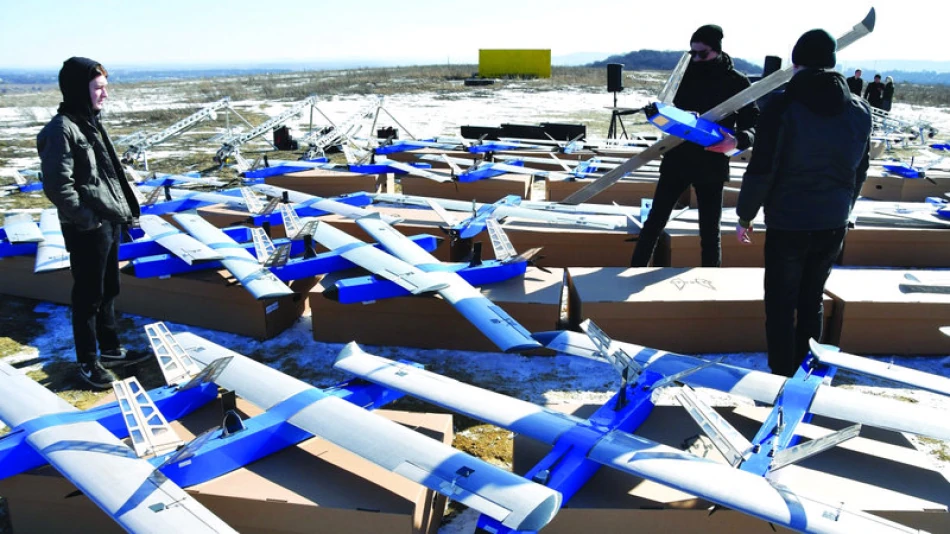
Cost-Effective Protest Drones: Ukraine's Innovative Defense Against Russian Assaults
Russia's Drone Swarm Strategy Forces Ukraine Into High-Stakes Defense Innovation Race
While Russian ground forces make costly, incremental gains in eastern Ukraine, Moscow's escalating drone campaign against Ukrainian cities represents a far more dangerous threat. Daily waves of unmanned aircraft are systematically targeting civilian and military infrastructure, dealing severe economic damage and psychological trauma that may prove more decisive than traditional battlefield advances. Ukraine's response—a crash program to deploy cheap interceptor drones—could reshape modern air defense doctrine.
The Mathematics of Modern Warfare
The scale of Russia's drone offensive has reached unprecedented levels. On July 9, over 700 drones attacked Kyiv and other targets, with 60% carrying warheads while the remainder served as decoys designed to exhaust Ukrainian air defenses. That week alone, President Volodymyr Zelensky reported that Russia launched more than 1,800 drones and 83 missiles in what he described as a campaign to "intensify terror against our cities and communities."
The composition of these attacks reveals Moscow's evolving strategy. Geran-2 drones, which comprised just 5% of attacks through March 2024, now account for approximately 15% of the aerial assault. This shift represents more than tactical adaptation—it signals Russia's confidence in overwhelming Ukrainian defenses through sheer volume.
Psychological Warfare Through Technology
Beyond immediate physical destruction, these prolonged nighttime attacks serve a calculated psychological purpose. "The goal is to deepen the feeling of insecurity and distrust in the state or defense forces," explained Serhiy Bratchuk, spokesperson for Ukraine's Southern Military Command. The relentless nature of these campaigns—often lasting entire nights—aims to erode civilian morale and confidence in government protection capabilities.
Russia's Drone Production Surge
Intelligence reports reveal Russia has quintupled its monthly Geran-2 production since last summer, aided significantly by increased supplies of dual-use Chinese components. By May 2024, two factories located approximately 1,500 kilometers east of the front lines were producing roughly 2,700 Geran-2 drones and 2,500 smaller Gerbera decoy drones monthly. Despite Ukrainian drone strikes on these facilities, production has remained largely unaffected and is expected to increase further.
Next-Generation Drone Technology
Since June 2024, Russia has deployed the enhanced G-2 missile system, equipped with video guidance, artificial intelligence, and improved software designed to counter electronic jamming. These upgraded weapons can fly at altitudes up to 4,000 meters and accelerate from 185 km/h to 400 km/h during their terminal approach, while carrying warheads weighing up to 90 kilograms—more than double the previous 40-kilogram payload.
The introduction of the G-3 missile represents an even more significant escalation. Powered by jet engines enabling speeds up to 600 km/h, these weapons cost approximately $1.4 million each compared to $200,000 for enhanced G-2 systems. This price differential illustrates Russia's willingness to invest heavily in overwhelming Ukrainian defenses.
The Economic Paradox of Modern Air Defense
Ukraine faces a classic asymmetric warfare dilemma: using multi-million-dollar missiles like IRIS-T systems to intercept $200,000 drones rapidly depletes sophisticated air defense assets needed for ballistic and cruise missile threats. This economic imbalance mirrors challenges faced by Israel against Hamas rockets and highlights a fundamental shift in modern warfare economics.
Traditional countermeasures—electronic warfare, mobile firing groups with heavy machine guns, and anti-aircraft artillery like German Gepard systems—have successfully destroyed most basic drones. However, these systems struggle against high-altitude Geran variants following unpredictable flight paths.
Ukraine's Interceptor Drone Gambit
Ukrainian military experts have identified cheap interceptor drones as the most promising solution. At least four Ukrainian companies, including Wyde Hunts and Besomar, alongside Germany's Titan and Estonia's Frankenberg, are producing various interceptor variants. General Oleksandr Syrskyi, Commander-in-Chief of Ukraine's Armed Forces, reports these interceptors achieve a 70% success rate against Russian Geran drones.
Industrial Scale Requirements
On July 25, Zelensky urged drone manufacturers to increase production to at least 1,000 interceptor drones daily, requiring "urgent funding" of $6 billion. If Russia cannot significantly increase its suicide drone production above the current ~200 daily units, this could favor Ukrainian defenses. However, matching Russian production remains highly ambitious, though Ukrainian officials claim they are "very close."
Each interceptor drone must cost no more than $5,000, reach speeds of approximately 300 km/h, and operate at altitudes up to 5,000 meters. These requirements demand fixed-wing aircraft rather than quadcopters, and the interceptors must physically collide with and destroy their targets—proximity alone is insufficient.
Technological Arms Race Intensifies
Significant technological hurdles remain. Interceptor drones must integrate with existing radar networks and require advanced AI for autonomous operation and jamming resistance. Max Enders from Germany's Titan expects an intense adaptation race, with both sides updating software in 15-20 day innovation cycles.
Future Russian capabilities may include communicating drone swarms designed to overwhelm defenses—a development that would fundamentally alter the tactical landscape. Ukraine's electronic warfare efforts, while initially successful against decoy drones, have proven less effective against combat variants as Russia continuously upgrades guidance systems.
Multi-Layered Defense Strategy
Defense analyst Olena Khryzanivska emphasizes that interceptor drones are not a complete solution. Short-range defense will still require artillery systems like Ukraine's Sky Sentinel autonomous turrets with heavy machine guns and Rheinmetall's Sky Nyx, designed specifically for swarm attacks. Neither system is yet available in large numbers.
Ukraine is also developing the Trizub laser system, theoretically capable of engaging aerial targets at 3,000+ meter altitudes. While interceptor drones currently represent the best hope, Russian Geran attacks continue advancing in both scale and sophistication.
Implications for Global Defense Strategy
This drone warfare evolution carries implications far beyond Ukraine's borders. The conflict demonstrates how relatively inexpensive unmanned systems can challenge expensive traditional air defenses, forcing military planners worldwide to reconsider defensive strategies and budget allocations. The success or failure of Ukraine's interceptor drone program may well determine whether small, cheap autonomous weapons fundamentally reshape modern warfare or whether traditional defense systems can adapt to maintain their effectiveness.
Most Viewed News

 Sara Khaled
Sara Khaled






